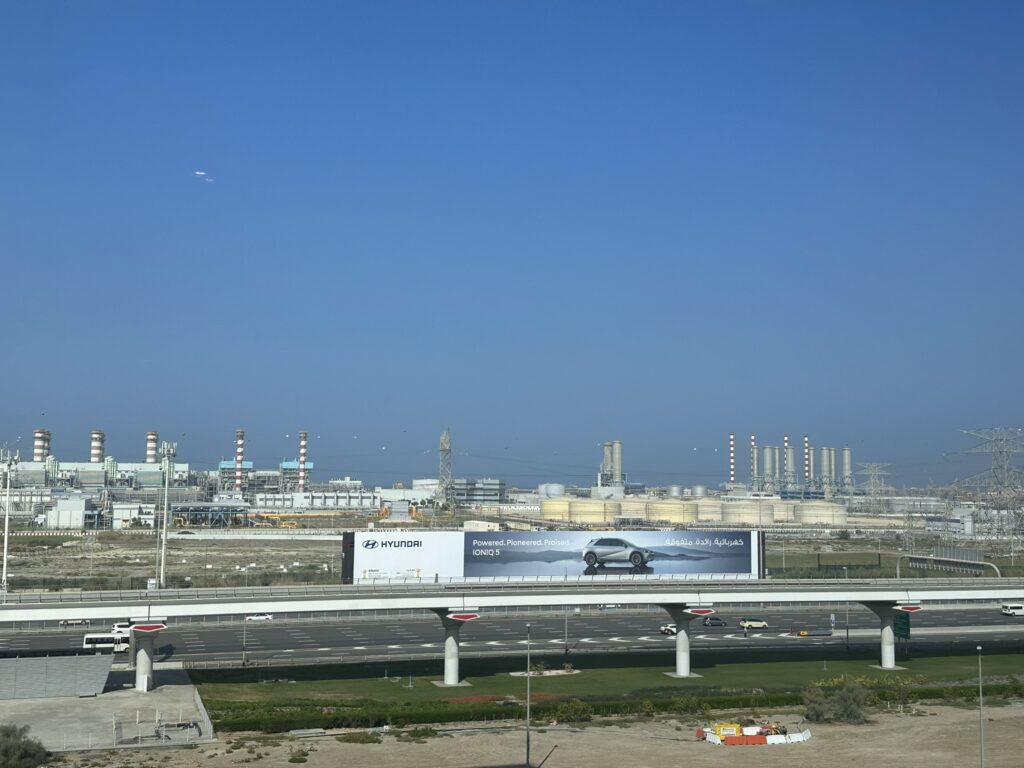Last November, The Climate Center’s Barry Vesser, Baani Behniwal, and Marc Victoria traveled to Dubai, United Arab Emirates for COP28 — the UN’s annual climate conference — to help coordinate the California delegation. With a record attendance of 84,000 people from 193 countries, this COP was massive.
You may be wondering why The Climate Center, an organization focused on California’s climate and clean energy policy, would go to COP in the first place. We’ll tell you why! First, we help get California policymakers on the global stage to share the progress California is making in implementing climate solutions. Second, we learn from others and catalyze the California leaders at COP with us to come home and do more here in California. And third, ironically at a conference halfway across the globe, we get more opportunities to build and deepen relationships with California decision-makers.

Dubai, the host city of this year’s COP, is an interesting place full of contradictions. While it is a huge, sprawling metropolis with remarkable skyscrapers, including the world’s tallest building, it also has horrible air quality and the world’s largest natural gas plant (pictured below). Among the many other ironies at this year’s conference was the selection of the United Arab Emirates’ state-owned oil company executive as the COP President — a choice met with backlash, especially as he was caught using COP as an opportunity to strike new oil deals with world leaders in attendance.

The COP was located at Expo City in Dubai, an impressive conference space spread out over an area the size of several college campuses combined. The conference itself was exhilarating, inspiring, and frustrating. It felt like drinking from a fire hose while spinning plates, juggling, and texting using your toes.

While we made a lot of progress with the California delegation, the official UN negotiations yielded underwhelming results. In large part due to the consensus-based process of COP — which requires the approval of all 193 nations — the formal outcome was a step in the right direction, but far from what the climate crisis demands. The agreement, which for the first time includes language about “transitioning away from fossil fuels in energy systems in a just, orderly and equitable manner,” still leaves too much wiggle room for countries to continue dragging their feet.
Current international commitments will not keep us below the 2 degrees Celcius target from the Paris Agreement. And these commitments are voluntary, meaning we may fall short of even this lackluster goal. The slow pace at which global negotiations have been moving underscores why California, as a global climate leader, must go further and faster.
Our team organized seven events focused on the managed decline of fossil fuels, appropriate uses for green hydrogen, natural carbon sequestration, California’s climate leadership, and more. We also organized press conferences, presented at other organizations’ events, attended dozens more, and had many private meetings with California legislators and agency officials.

Our panel on Managing the Transition Away from Fossil Fuels included Liane Randolph, Chair of the California Air Resources Board, Monique Limón, California State Senator, Serena McIlwain, Maryland Secretary of the Environment, Richard Folland, Head of Policy and Engagement at Carbon Tracker Initiative, and Collin Rees, US Program Manager at Oil Change International.
When it comes to fossil fuels, the United States is a big part of the problem. We lead all countries in planned new oil and gas production by 2035, with planned output more than triple that of the next largest producer, Canada. Even with the clean energy investments of the Inflation Reduction Act and other good things we’re doing, the United States currently plans to expand natural gas exports by 92 percent by 2035. Our chances of staying below 2 degrees Celsius are out the window if this happens.
California plays a big role as well, as the seventh-largest oil-producing state in the country. We also give an estimated $8 billion in subsidies to the oil industry each year. Holding the oil and gas industry accountable and seeing through greenwashing schemes will be paramount, but at COP, there were 2,540 registered oil lobbyists working to promote false solutions.
We must also get organized labor on board to equitably transition off fossil fuels. That means we need good jobs in renewable energy that pay comparable wages to unionized workers in the oil and gas sector. And these jobs need to be available now, not ten years from now. As a start, California should ban new oil and gas permits, accelerate our timeline for eliminating fossil fuels from our homes, vehicles, electricity system, and more, and join the Beyond Oil & Gas Alliance (BOGA) that was launched two years ago at COP26 in Glasgow.

While COP28 failed to deliver on fossil fuels, we were encouraged by the inclusion of nature-based solutions as one of the four main themes for the event. This year, countries pledged more than $2.5 billion to protect and restore nature, recognizing the important role of natural ecosystems in building resilience to climate extremes.
To underscore the many benefits of conservation and restoration, we organized a pavilion panel discussion on leveraging nature-based solutions to get to 1.5 degrees, as well as an official side event on healthy soils. We were fortunate to have panelists from around the world, including California leaders like Tribal Affairs Secretary Christina Snider-Ashtari and Food and Agriculture Secretary Karen Ross, speak about the policy pathways to scale up nature-based climate solutions.

While the overall results of COP28 were disappointing, we can’t let up. International agreements are absolutely needed when addressing an issue as complex as the climate crisis, and we as a global community must continue to push our leaders to do more. At the same time, we should not expect that the COP process will deliver us to a climate-safe future on its own. We all need to advocate at the state and national levels to urge our governments to move faster.
California, with its historic investment in climate solutions, technological innovation, large and diverse economy, and being on the frontlines of climate impacts, must continue to lead the world and create a model for climate action that others can follow.

Barry Vesser
Chief Program Officer
